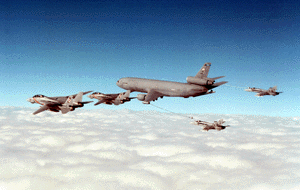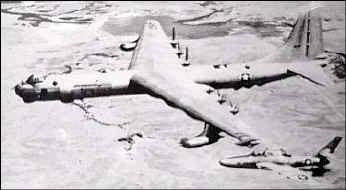 In order to deploy overseas today, fighters must link up with several refuelers
en route. This is complicated, especially at night. The refuelers require overseas bases and burn
a lot a fuel to just link up with the fighters. The fighter pilots arrive
exhausted and the long journey causes
engine wear. The US Air Force can easily expand its capabilities
by adding fighter attachment points on its refueler aircraft.
In order to deploy overseas today, fighters must link up with several refuelers
en route. This is complicated, especially at night. The refuelers require overseas bases and burn
a lot a fuel to just link up with the fighters. The fighter pilots arrive
exhausted and the long journey causes
engine wear. The US Air Force can easily expand its capabilities
by adding fighter attachment points on its refueler aircraft.
Allowing a refueler to act as an "Airborne Aircraft Carrier" and ferry fighter aircraft overseas allows pilots to relax and eliminates the complex task of coordinating multiple aerial refuelings. Hardpoints on the bottom of the refueler aircraft, similar to a bomb attachment hardpoints, would allow modified fighters to dock so fighter pilots can idle their engine and take a nap. When they reach their destination, the tanker crew can wake up the pilots who release themselves to land. This allows a tanker to carry several fighters to distant overseas bases. This is not a new idea, B-36 "Tom Toms" once towed fighters. (below)
 The US Air Force should realize that tankers towing fighter-bombers provide very long-range strike options. The US Air Force
once deployed F-84 fighters to escort photo recon B-36s in the 1950s using the
FICON concept. (below) The F-85 "Goblin" fighter was developed
to be carried by B-36 bombers. There were other types of what were known
as "parasite aircraft." These projects were never adopted because aerial
refueling was perfected that allowed fighters to accompany strategic bombers all the way to the target.
The US Air Force should realize that tankers towing fighter-bombers provide very long-range strike options. The US Air Force
once deployed F-84 fighters to escort photo recon B-36s in the 1950s using the
FICON concept. (below) The F-85 "Goblin" fighter was developed
to be carried by B-36 bombers. There were other types of what were known
as "parasite aircraft." These projects were never adopted because aerial
refueling was perfected that allowed fighters to accompany strategic bombers all the way to the target.
Imagine eight KC-10s, each towing three F-16 fighter-bombers, escorted by an AWACs airborne radar aircraft. If enemy fighters approach, the 24 F-16s can be released to fight, otherwise they can conduct a strike mission. Afterwards, they can link up with the KC-10s and dock for the long ride home. This allows a fighter-bomber squadron based in Virginia to conduct air strikes anywhere in the world without having the pilots refuel several times and exhausted from flying.
![]()
Colonel George D. Kramlinger USAF authored a detailed proposal for Airborne Aircraft Carriers. His idea is more complex in that a fighter-bomber would attach on the back of its carrier to rearm. This idea is more ambitious, but worthy of study because piggybacked aircraft are nothing new. The huge Space Shuttle orbiter was routinely moved in this manner. Simply the existence of airborne aircraft carriers requires an enemy to expect attack from very long ranges, and allows plausible denial when silent allies allow use of their airbases to launch attacks.
©2015 www.G2mil.com